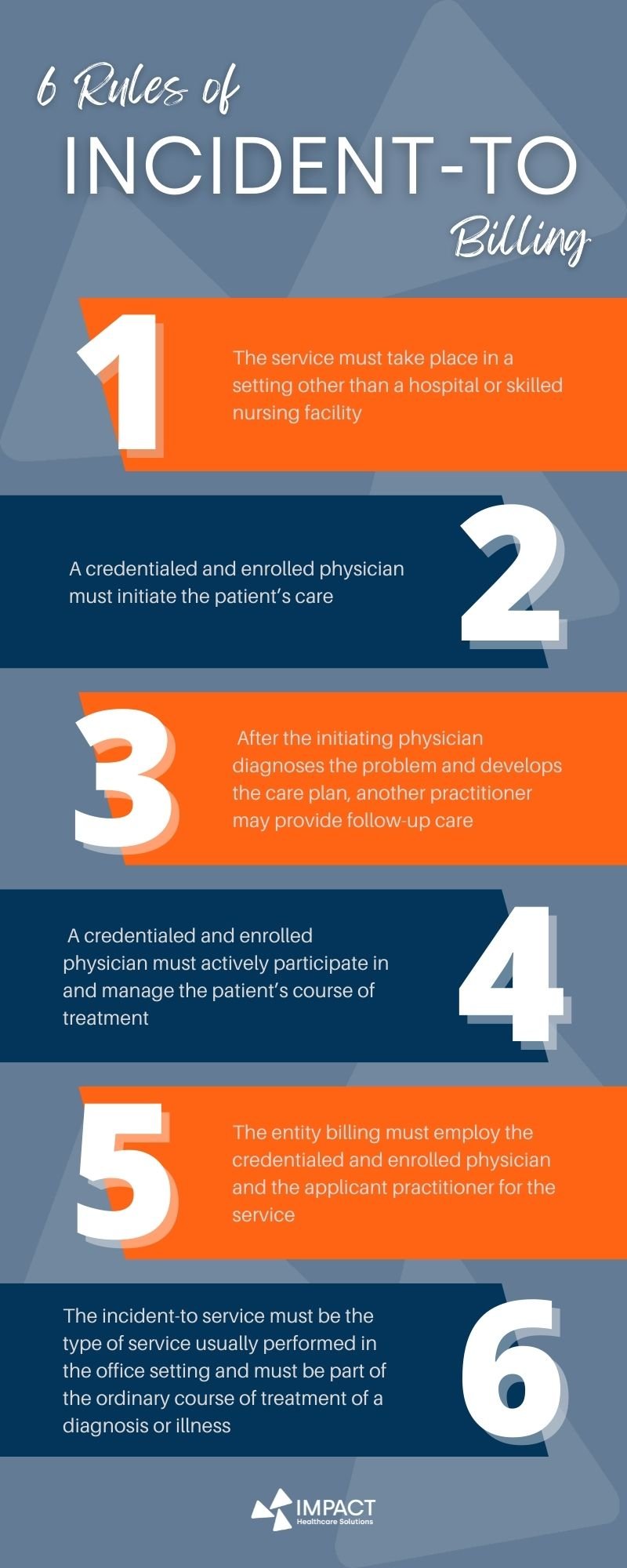The Hidden Gem of Incident-To Billing
A client called me one day to tell me that he had hired a new physician to join his expanding medical staff, and my team needed to begin enrolling that physician with commercial insurance networks, Medicare, and Medicaid. Easy enough, but then I felt anxiety creeping in, and my head began to hurt as if the inevitable was about to happen.
And then it happened.
“By the way, she started seeing patients today.”
Then things got worse. As I began to explain the importance of enrollment in getting paid for services provided, the typical timeline to complete and submit the paperwork, meet the (often unreasonable) demands of each insurance company, and the inevitable wait (and wait and wait) for network approvals, my client interrupted me.
“Don’t worry. We can bill everything under me.”
My response was simple and direct. “No, we cannot.”
Generally, a physician cannot bill for services using another physician’s National Provider Identifier.
Submitting such a claim to a government program misrepresents who provided the service and will likely attract scrutiny under the False Claims Act. Furthermore, the same conduct aimed at commercial insurance companies can result in a breach of contract.
This dilemma has two paths forward:
1) bill as a group practice or
2) comply with incident-to rules—the subject of this article.
Understand Incident-To Rules
Generally, claims should represent the services performed and the physician who performed them. While there are numerous rules for incident-to billing, there are six basic requirements:
1. The service must take place in a setting other than a hospital or skilled nursing facility.
2. A credentialed and enrolled physician must initiate the patient’s care.
3. After the initiating physician diagnoses the problem and develops the care plan, another practitioner may provide follow-up care.
4. A credentialed and enrolled physician must actively participate in and manage the patient’s course of treatment.
5. The entity billing must employ the credentialed and enrolled physician and the applicant practitioner for the service.
6. The incident-to service must be the type of service usually performed in the office setting and must be part of the ordinary course of treatment of a diagnosis or illness.
How does this help a new, unenrolled physician?
42 CFR 410.26 describes services and supplies incident to a physician's professional services in a non-institutional setting. The regulation reads, "Medicare Part B pays for services and supplies incident to the service of a physician (or other practitioner)." 42 CFR 410.26(b). "Services and supplies must be furnished by the physician, practitioner with an incident to benefit, or auxiliary personnel." 42 CFR 410.26(b)(6)(emphasis added).
"Auxiliary personnel means any individual who is acting under the supervision of a physician . . . and meets any applicable requirements to provide incident to services, including licensure, imposed by the State in which the services are being furnished." 42 CFR 410.26(a)(1)(emphasis added).
The Centers for Medicare and Medicaid published a clarification of its definition of "auxiliary personnel" in response to the public comment for a 2002 Final Rule. The comment, for context, reads as follows:
Many commenters wanted us to restrict the definition of auxiliary personnel so that only certain individuals may perform a given incident to service. For example, they want us to mandate that only audiologists may perform cochlear implant rehabilitation services as incident to services. Likewise, they want us to permit only physical or occupational therapists to perform physical or occupational therapy as incident to services. In support, they noted that section 4541(b) of the BBA amended section 1862(a)(20) of the Act and required that physical or occupational therapy furnished as an incident to service meet the same requirements outlined in the physical or occupational therapy benefit set forth in sections 1861(g) and (p) of the Act.
Revisions to Payment Policies and Five-Year Review of and Adjustments to the Relative Value Units Under the Physician Fee Schedule for Calendar Year 2002, 66 Fed. Reg. 212 (Nov. 1, 2001).
The Centers for Medicare and Medicaid provided the following response clarifying the definition of "auxiliary personnel" and the department's intent when it drafted the wording of the regulation:
We have not further clarified who may serve as auxiliary personnel for a particular incident to service because the scope of practice of the auxiliary personnel and the supervising physician (or other practitioner) is determined by State law. We deliberately used the term any individual so that the physician (or other practitioner), under his or her discretion and license, may use the service of anyone ranging from another physician to a medical assistant. In addition, it is impossible to exhaustively list all incident to services and those specific auxiliary personnel who may perform each service.
Id. (emphasis added).
When billing a federal program under the incident-to rule, remember that compliance with the rules is paramount to avoid unwanted scrutiny. Physicians are typically not used to practicing within the confines of the incident-to rule, and monitoring a physician’s services for compliance is usually necessary.
Notice that the commentary above applies only to Medicare. Some commercial insurances also recognize incident-to services. Check your contracts to be sure.
Despite its limitations, the incident-to rule offers a means for a newly hired physician to work, provide services, and generate revenue during the credentialing and enrollment processes.
Here is a link to the CMS clarification: https://www.govinfo.gov/content/pkg/FR-2001-11-01/html/01-27275.htm
Written By: Landon Tooke, MLS, CHC, CCEP, CPCO, CHCSP, CHSRAP
Twitter: @LandonNTooke
LinkedIn: Landon Tooke

